Abstract
After a fatal case of invasive group A streptococcal disease, serotype T-1, in a child care centre, group A streptococcal T-1 prevalence was measured and risk factors for carriage were determined. A total of 87% (224/258) had throat culture tests. Group A streptococcus was isolated from 57 (25%), and of the 50 isolates serotyped, 38 (76%) were T-1. Group A streptococcal T-1 prevalence was 18% (38/217) and six of nine rooms had children with group A streptococcal T-1 isolates. The risk of group A streptococcal T-1 carriage was increased for children who shared the index case's room (odds ratio (OR) = 2.7; 95% confidence interval (CI) = 0.8 to 9.4) and for each additional hour per week in child care (OR = 1.03; 95% CI = 1.001 to 1.061); and decreased in children taking antibiotics in the preceding four weeks (OR = 0.2; 95% CI = 0.1 to 0.9). Carriage of the invasive group A streptococcal strain could not be determined by identified risk factors alone.
Full text
PDF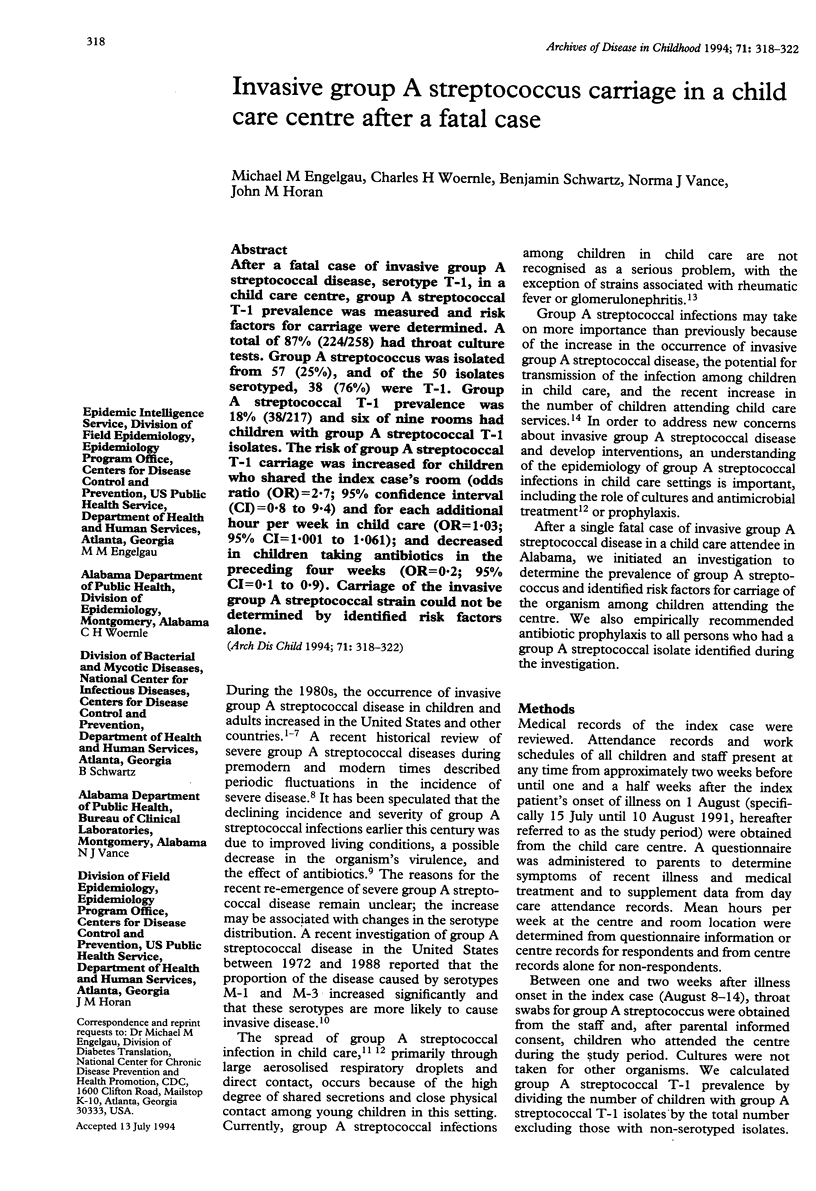
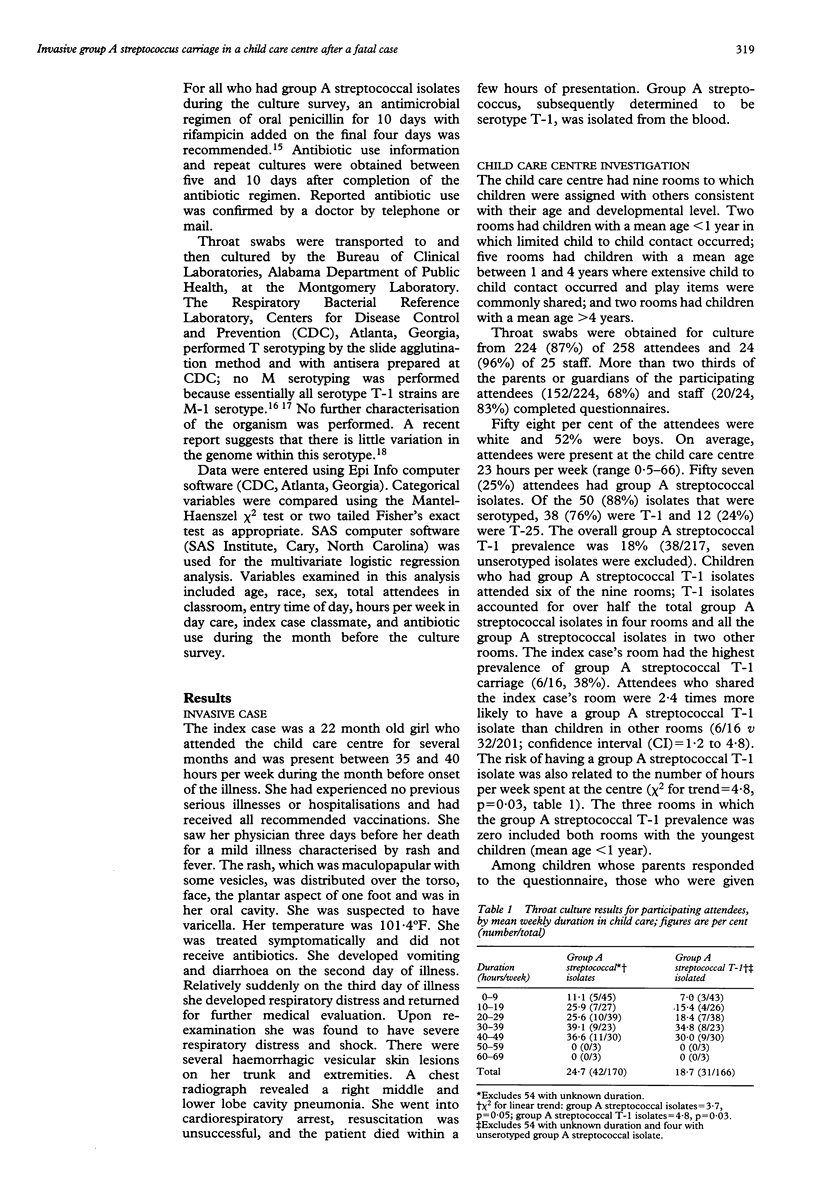
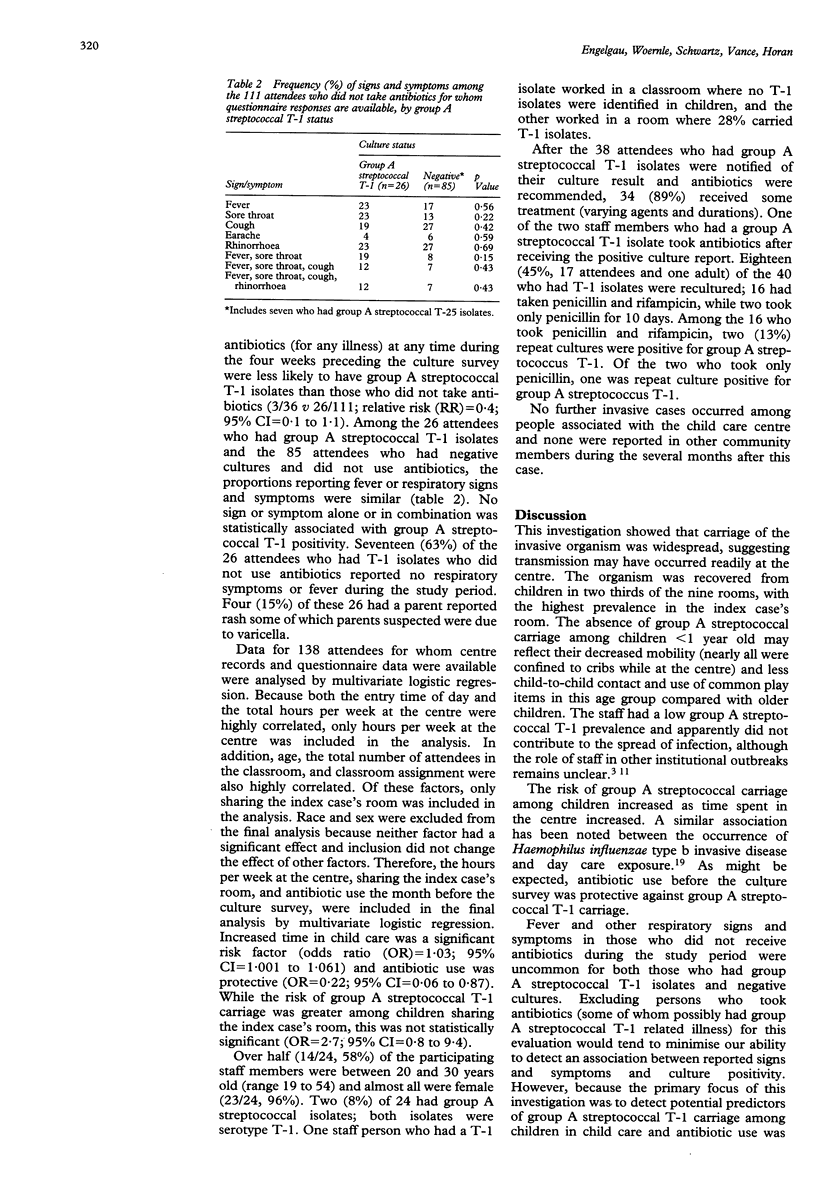
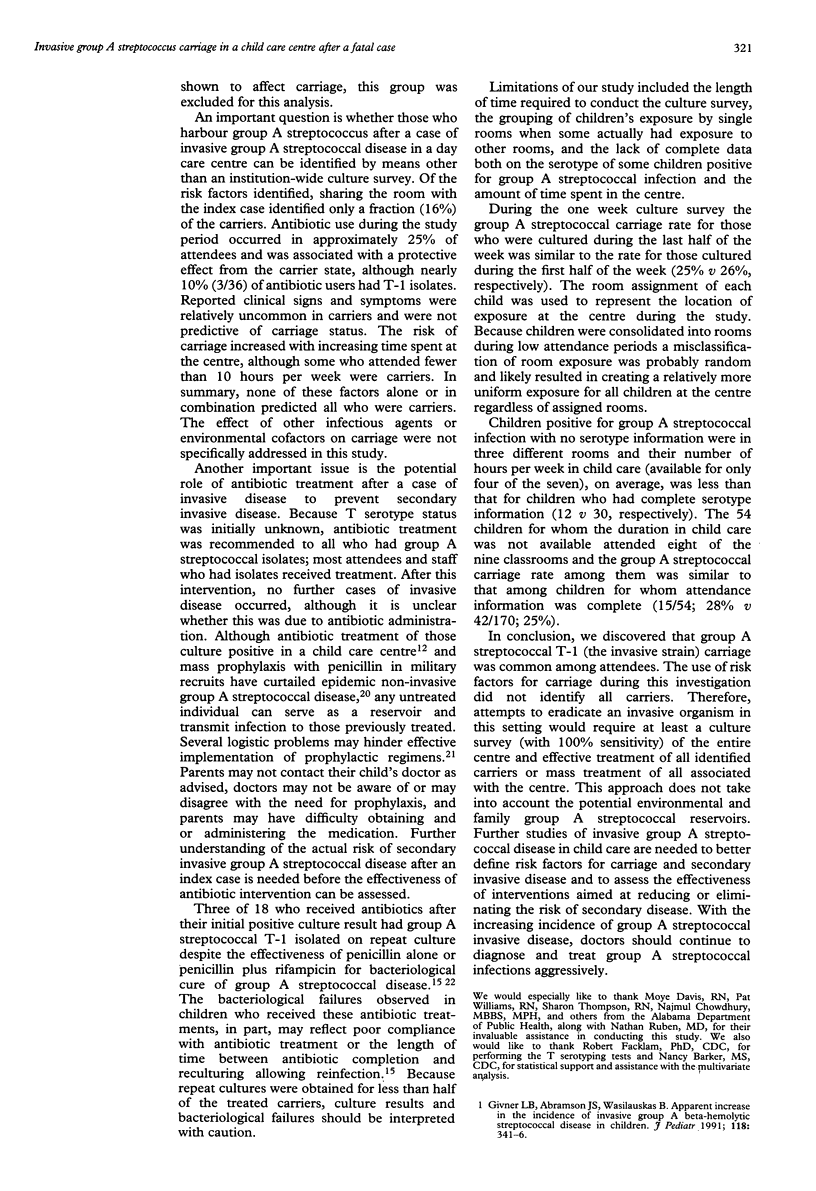
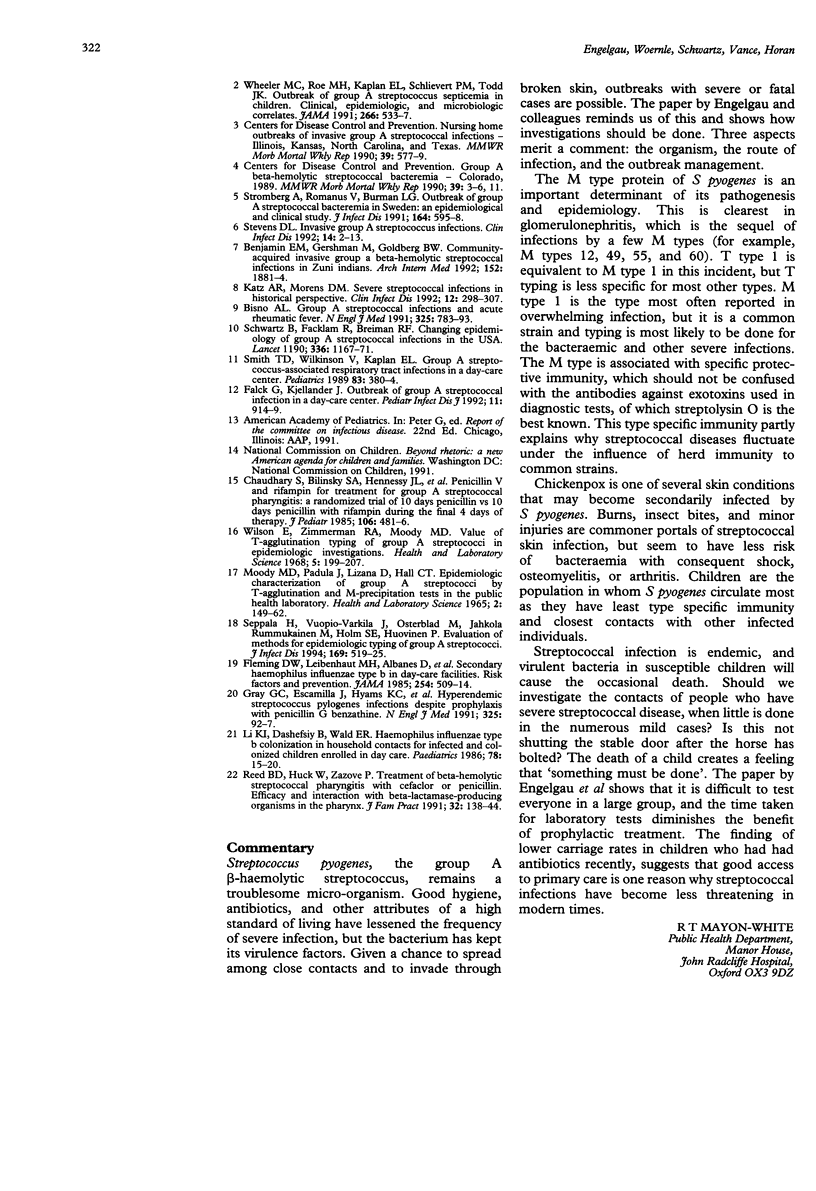
Selected References
These references are in PubMed. This may not be the complete list of references from this article.
- Benjamin E. M., Gershman M., Goldberg B. W. Community-acquired invasive group A beta-hemolytic streptococcal infections in Zuni Indians. Arch Intern Med. 1992 Sep;152(9):1881–1884. [PubMed] [Google Scholar]
- Bisno A. L. Group A streptococcal infections and acute rheumatic fever. N Engl J Med. 1991 Sep 12;325(11):783–793. doi: 10.1056/NEJM199109123251106. [DOI] [PubMed] [Google Scholar]
- Chaudhary S., Bilinsky S. A., Hennessy J. L., Soler S. M., Wallace S. E., Schacht C. M., Bisno A. L. Penicillin V and rifampin for the treatment of group A streptococcal pharyngitis: a randomized trial of 10 days penicillin vs 10 days penicillin with rifampin during the final 4 days of therapy. J Pediatr. 1985 Mar;106(3):481–486. doi: 10.1016/s0022-3476(85)80687-9. [DOI] [PubMed] [Google Scholar]
- Falck G., Kjellander J. Outbreak of group A streptococcal infection in a day-care center. Pediatr Infect Dis J. 1992 Nov;11(11):914–919. doi: 10.1097/00006454-199211110-00002. [DOI] [PubMed] [Google Scholar]
- Fleming D. W., Leibenhaut M. H., Albanes D., Cochi S. L., Hightower A. W., Makintubee S., Helgerson S. D., Broome C. V. Secondary Haemophilus influenzae type b in day-care facilities. Risk factors and prevention. JAMA. 1985 Jul 26;254(4):509–514. [PubMed] [Google Scholar]
- Givner L. B., Abramson J. S., Wasilauskas B. Apparent increase in the incidence of invasive group A beta-hemolytic streptococcal disease in children. J Pediatr. 1991 Mar;118(3):341–346. doi: 10.1016/s0022-3476(05)82144-4. [DOI] [PubMed] [Google Scholar]
- Gray G. C., Escamilla J., Hyams K. C., Struewing J. P., Kaplan E. L., Tupponce A. K. Hyperendemic Streptococcus pyogenes infection despite prophylaxis with penicillin G benzathine. N Engl J Med. 1991 Jul 11;325(2):92–97. doi: 10.1056/NEJM199107113250204. [DOI] [PubMed] [Google Scholar]
- Katz A. R., Morens D. M. Severe streptococcal infections in historical perspective. Clin Infect Dis. 1992 Jan;14(1):298–307. doi: 10.1093/clinids/14.1.298. [DOI] [PubMed] [Google Scholar]
- Li K. I., Dashefsky B., Wald E. R. Haemophilus influenzae type b colonization in household contacts of infected and colonized children enrolled in day care. Pediatrics. 1986 Jul;78(1):15–20. [PubMed] [Google Scholar]
- MOODY M. D., PADULA J., LIZANA D., HALL C. T. EPIDEMIOLOGIC CHARACTERIZATION OF GROUP A STREPTOCOCCI BY T-AGGLUTINATION AND M-PRECIPITATION TESTS IN THE PUBLIC HEALTH LABORATORY. Health Lab Sci. 1965 Jul;2:149–162. [PubMed] [Google Scholar]
- Reed B. D., Huck W., Zazove P. Treatment of beta-hemolytic streptococcal pharyngitis with cefaclor or penicillin. Efficacy and interaction with beta-lactamase-producing organisms in the pharynx. J Fam Pract. 1991 Feb;32(2):138–144. [PubMed] [Google Scholar]
- Schwartz B., Facklam R. R., Breiman R. F. Changing epidemiology of group A streptococcal infection in the USA. Lancet. 1990 Nov 10;336(8724):1167–1171. doi: 10.1016/0140-6736(90)92777-f. [DOI] [PubMed] [Google Scholar]
- Seppälä H., Vuopio-Varkila J., Osterblad M., Jahkola M., Rummukainen M., Holm S. E., Huovinen P. Evaluation of methods for epidemiologic typing of group A streptococci. J Infect Dis. 1994 Mar;169(3):519–525. doi: 10.1093/infdis/169.3.519. [DOI] [PubMed] [Google Scholar]
- Smith T. D., Wilkinson V., Kaplan E. L. Group A streptococcus-associated upper respiratory tract infections in a day-care center. Pediatrics. 1989 Mar;83(3):380–384. [PubMed] [Google Scholar]
- Stevens D. L. Invasive group A streptococcus infections. Clin Infect Dis. 1992 Jan;14(1):2–11. doi: 10.1093/clinids/14.1.2. [DOI] [PubMed] [Google Scholar]
- Strömberg A., Romanus V., Burman L. G. Outbreak of group A streptococcal bacteremia in Sweden: an epidemiologic and clinical study. J Infect Dis. 1991 Sep;164(3):595–598. doi: 10.1093/infdis/164.3.595. [DOI] [PubMed] [Google Scholar]
- Wheeler M. C., Roe M. H., Kaplan E. L., Schlievert P. M., Todd J. K. Outbreak of group A streptococcus septicemia in children. Clinical, epidemiologic, and microbiological correlates. JAMA. 1991 Jul 24;266(4):533–537. [PubMed] [Google Scholar]
- Wilson E., Zimmerman R. A., Moody M. D. Value of T-agglutination typing of group A streptococci in epidemiologic investigations. Health Lab Sci. 1968 Oct;5(4):199–207. [PubMed] [Google Scholar]


